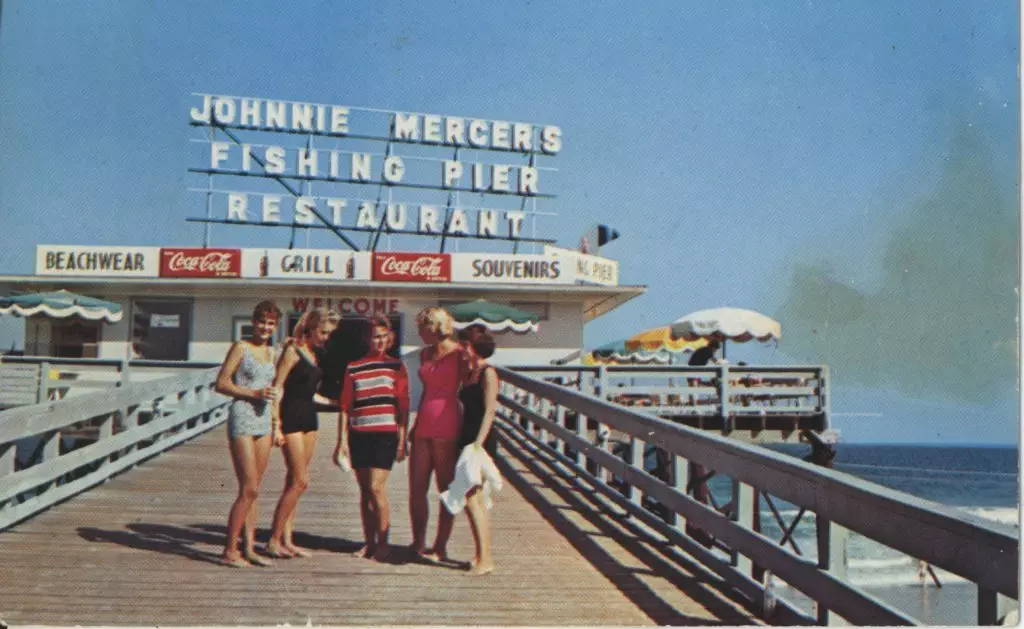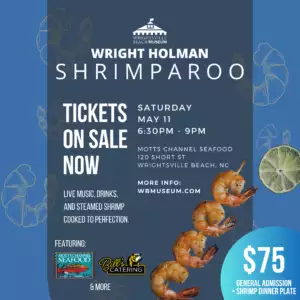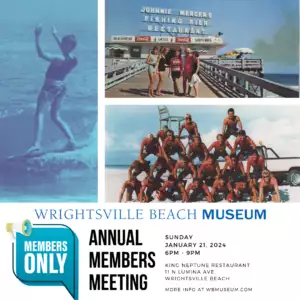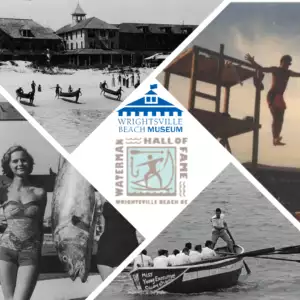Waves greet the shoreline as seashells reveal themselves as the tide draws back. Sunshine peeks through the early morning clouds, while seagulls fly overhead chirping. During the calm of the beach, it’s difficult to imagine waves reaching heights of 10 feet or more. Historically, there have been instances where Mother Nature brought her wrath to many homes at Wrightsville Beach.
After Hurricane Hazel made landfall in mid-October 1954, the storm caused considerable damage to 530 homes while fully destroying 89. One of the largest in history, the natural disaster marked a 12-foot storm surge to the area. Such severe storms are one of many exhibits on display at the Wrightsville Beach Museum of History.
“We have a hurricane post in the side yard of the museum,” says Madeline Flagler, executive director of the museum. Many folks have flocked to it, especially since last fall’s Hurricane Florence, which is now measured on it, too. The outside exhibit was done by Dylan Rosbrugh, as part of his Eagle Scout project. It covers Saffir-Simpson wind scale and storm-surge measurements. “Come by and stand next to it to see how massive the storm surge is,” Flagler suggests.
Inside the museum are details about Hurricane Hazel’s storm tracker in the Atlantic. As well, Hazel makes an appearance in the museum’s pop-up exhibit, “Loop Through History.” It’s featured on sign number two, out of 25, which are situated around Wrightsville Beach’s most popular fitness area, The Loop.
The exhibit started in 2016 around the 2.45-mile stretch to help passersby learn more about the island. “Weekends are high traffic, when we expect the most people to see it,” Flagler asserts. “We estimate a minimum of 1,500 people see the signs each year.”
The exhibit is showcased eight weekends annually, and this year will be no exception. Participants should set aside an hour to walk around the Loop to see all the signs.
Donna Starling, a museum board member for Wrightsville Beach, developed the exhibit with one idea in mind: to bring history out to the people. Also, it was a way to think outside the box.
“Everyone is free to learn and take their time and walk it,” Starling exclaims. “Sometimes, it’s intimidating, coming off the beach with sandy feet. You feel like, Oh, I don’t want to go into the museum. But, [on the Loop], whether you’re in tennis shoes and shorts, or in a bathing suit and flip-flops, you can enjoy the history of Wrightsville Beach.”
In addition to illustrating different moments on the island, Loop Through History is a fundraiser for the museum. Families and individuals can sponsor a sign for a year.
“Most people choose a sign that has a special meaning for them,” Flagler offers, “[for example], their father worked at the Saline Plant or Nickel Plant; they live near where the sign is placed; their mother worked at Newell’s; their children went to Wrightsville Beach School; [or] they roller skated at Lumina.”
Wrightsville Beach Elementary School (sign five), opened in 1953, and has a special place in Starling’s heart. Her family’s history goes back on the island. “My father went there, I went there, and my children went to [what was then known as] Wrightsville Beach School,” Starling reveals, “so three generations.”
Starling and her family have seen changes on the island, too, such as Johnnie Mercer’s Fishing Pier (sign eight) going from wood to concrete. When Starling’s father was young, he would skip school and fish off the pier; the principal always knew where to find him. “That [story was] pretty funny,” Starling remembers.
Starling favors sign 11, Lumina Pavilion—once known as “The Playground of the South.” Having opened in 1905, the pavilion was the hot spot of southeastern NC. It hosted famous jazz acts like Cab Calloway, and in its latter years famous rock acts like Jerry Lee Lewis. In the ‘60s, it hosted the Miss North Carolina pageant, but also Ronald Reagan, who attended what was the well-known Lumina Weekend.
Aside from Lumina’s famous dance floor, it also had a bowling alley, restaurant, and would screen movies on the side of the building. Locals were able to access it via the trolley (sign 18), a system created by Hugh MacRae. Lumina Pavilion was demolished in 1973 to make room for more condominiums. Lack of clear vision for how to use the massive building on the beach led to its demolition.
“If you ever stop [at the sign] on the loop,” Starling says, “you’ll hear people talking about their grandmother [and] their grandfather getting engaged in front of Lumina on the beach.”
Other razed structures appear on signs, like the babies hospital (sign 25) and The Oceanic Hotel (sign 9)—each of which, along with the pavilion and trolley, have other exhibits inside Wrightsville Beach Museum of History. The “Great Fire of 1934” burned to the ground the Oceanic Hotel and 125 homes surrounding it. In 2008 the babies hospital was bulldozed, due to the building not having an historic registry. The museum did not have leverage, access or funds to preserve the buildings at the time. “Some were public [and] some were private,” Flagler mentions. “A lot of them involved much more funding than we could have provided.”
In 2018 the odds fell in the museum’s favor when they acquired the 1924 Ewing-Bordeaux Cottage. The Bordeaux family bought it in 1971 and were only the second owners of the cottage after Mrs. Cora Ewing. The cottage survived the great fire, and within seven years, nine hurricanes in the 1950s.
Since it was solidified an historic structure from the Wrightsville Beach Landmark Commission, the museum was able to acquire the landmark and add it to the historic square, designated by the Town of Wrightsville Beach. The square accommodates historic structures that normally would have been torn down. The museum itself, on Salisbury Street, was the first donation, acquired from the 1909 Myers Cottage. The historic square took off, with three more cottages or houses added since: The 1940 Bender-Howell Cottage hosts the Wrightsville Beach Visitor’s Center, along with the 1946 Historic Palmgren-O’Quinn house providing education on local coastal wildlife and habitats through hands-on activities and tours of natural environments. The museum took advantage of adding the 1924 Ewing-Bordeaux Cottage to expand its programs and exhibits. The cottage will showcase the best of its beach community, via coastal professions and even water sports on the island as a part of the Waterman Hall of Fame.
For more information on the Wrightsville Beach Museum and its many exhibits, or to sponsor one of its signs in Loop Through History, visit wbmuseumofhistory.com.
Details:
Loop Through History
Wrightsville Beach Loop
Sat. – Sun., March 16-17
The Loop Wrighstville Beach, Free
WB Museum of History
303 W Salisbury St.
(910) 256-2569 • Free admission Tues.-Fri., 10 a.m. – 4 p.m.
Sat., noon – 5 p.m.
Sun., 1 p.m. – 5 p.m.





